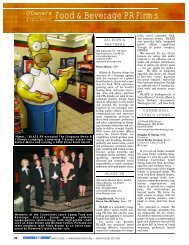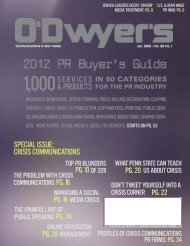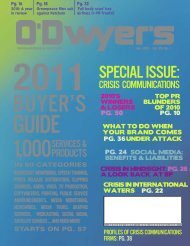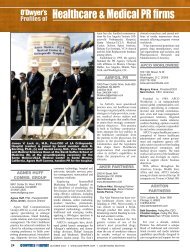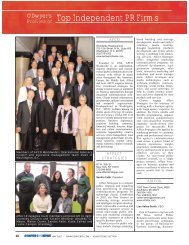multicultural pr special report - Odwyerpr.com
multicultural pr special report - Odwyerpr.com
multicultural pr special report - Odwyerpr.com
- No tags were found...
You also want an ePaper? Increase the reach of your titles
YUMPU automatically turns print PDFs into web optimized ePapers that Google loves.
market for the network, and said SouthAmerica continues to be<strong>com</strong>e a source ofimmense interest.“Increasingly, from a global <strong>com</strong>merceperspective, these markets matter. Wespend a lot of time touching on how we canmake sure our clients have the resourcesthey need when they move into new markets,and to make sure we all understandhow to make that transition as seamlessly aspossible,” she said.The growth of various<strong>com</strong>munications industriesin IPREX’sNordic region, and anincrease in clientdemand for core <strong>pr</strong>acticeareas like publicaffairs, has also beenconsiderably strong.Donna Vandiver,PinnaclePresident.Tunheim said the networkis interested inconsumer <strong>pr</strong>oduct markets,as well clean techand <strong>multicultural</strong>industries, all areas that have been hit by theeconomy but are <strong>pr</strong>epped for a full recovery.“Both on the consumer side and in business-to-businessareas, all these marketshave many facets,” she said. “We’re in avery fragile place and Ithink we tend to look atthings and believeeverything willim<strong>pr</strong>ove. They will, butit won’t be a straightline up or across theboard. Economiesrecover when the economystarts to spend.Patricia Perez, The markets that arePRGNdoing best are the onesPresident. that can pace themselves.”Pinnacle stabilizes lossesThis time last year, things weren’tlooking so good for Pinnacle. The firstand oldest of the global PR networks hadlost 14 partner firms between 2008 and2009, a blow that came only after losingan additional dozen firms the year before.In the time since however, Pinnacle hasmanaged not only to curb further membercuts, but to strengthen their roster andeven grow in several markets, an unlikelyturn of events given the realities of therecent global economy.With 36 current member firms,Pinnacle <strong>report</strong>ed <strong>com</strong>bined total revenuessomewhere between $75 and $100million, earnings on par with last year’s.Pinnacle lost several partners in Asiabut added new shops in the Middle Eastand North America. The network haseven added three firms since May, and iscurrently in negotiations to add anotherforeign member, one that will “substantiallyextend” the network’s global coverage,according to Pinnacle PresidentDonna Vandiver, who is also Presidentand CEO of The Vandiver Group in St.Louis.Vandiver said that while the networkdoesn’t view a single region of emerging<strong>com</strong>munications shops as having morecurrent urgency than others, she notedthat several <strong>pr</strong>actice area groups — socialmedia, sustainability, healthcare, energyand public affairs — are <strong>pr</strong>esent focusesof attention for the network, the result ofa recently <strong>com</strong>pleted member survey.“I think we’re seeing more interest inareas of the world where maybe we hadn’ttaken a close enough look at before,”Vandiver said. “The downturn was a realone-two punch for a lot of firms.Thankfully, we’re seeing a light at theend of the tunnel and it isn’t a train.”Steady growth for PRGNPRGN’s <strong>com</strong>bined revenues for the pastyear were slightly over $100 million, amodest dip from 2009’s $110 million.PRGN gained one partner in NorthAmerica and lost one in Asia, keeping theirtotal roster of partners — 42 — the same aslast year. Overall, the network has experiencedmodest growth, adding a total of adozen partners in the past three years.PRGN’s recently elected President,Patricia Perez of Los Angeles-based <strong>multicultural</strong>agency VPE, told O’Dwyer’s thatwhile the network’s growth has been consistent,it has played out in various waysOrganizations remain cautious onPR spending in 2010 as the industryemerges from a tough ’09,according to a biennial study by theUniversity of California’s AnnenbergSchool for Communication andJournalism.A survey of spending by the schoolshows that while ’09 wasn’t as painful toPR as <strong>pr</strong>evious recessions, budgets areexpected to increase only incrementallythis year.Jerry Swerling, director of PR studiesand the Strategic PR Center at USC, saidthe recent recession wasn’t as calamitousas the downturn that leveled tech PR at theturn of the last decade. He said the industrycame out of last year in relativelydecent shape for a recovery.“The dot-<strong>com</strong> phenomenon was really aPR bubble that, when it finally burst hit the<strong>pr</strong>ofession the way this recession hit theacross the globe as a result of the recession.“The interesting thing about global <strong>com</strong>municationsis that it takes a while for aregion’s <strong>pr</strong>oblems to reach the global market.When the U.S. was reeling, the rest ofthe world was on easy street. Now it seemsto be going around.”When placed in the purview of the network’s<strong>special</strong>ty focus, Perez said Europeremains an area of attention for PRGN. Shealso noted that Asia (China and India,specifically) have be<strong>com</strong>e growing sourcesof interest for the network.“It’s not just the concept of having <strong>com</strong>munications,it’s the concentration and thevery specific differences that exist in thosemarkets that have been important,” shesaid.“The interesting part is that you don’tknow what markets are going to be criticalfor clients. But when you have an establishedglobal <strong>com</strong>munications team it givesyou seasoned <strong>pr</strong>ofessionals with on-thegroundability, local expertise, and entre<strong>pr</strong>eneurialdrive at the same time. It’s thebest of both worlds for people who want tobe independent but at the same time havethe opportunity to take advantage of globalcampaigns.”“Communications truly is global,” shecontinued. “Everything is based not onlyon engagement but also personal engagement.When choosing a firm, the marketand the capabilities are important. If youonly have two dollars, one should go into<strong>com</strong>munications. When times were hardour members were still consistent in seeingthe value that <strong>com</strong>munications gives.” PR sector spending ‘cautious’ for 2010housing industry,” he said. Swerling notedthat PR is much better established today asa key strategic player (“rather than just ahype machine”) and added that socialmedia and the “fishbowl” environmentplay to PR’s strong suits.The USC study, known as GAP, anacronym for Generally AcceptedPractices, found that nearly 21 percent ofPR budgets rose last year while 42.5% fell.A large percentage — 36.6 — saw little orno change, the study found.Swerling said solid numbers <strong>report</strong>ed inthe first quarter of 2010 by ad/PR holding<strong>com</strong>panies are a good sign for the year, buthe noted the GAP study’s finding thatclients expect budgets to increase a mere1.6% this year. Corporate respondents tothe study cited an expected 1.9% increase.Nearly 29% said they expect budgets toincrease in 2010 over 2009, while halfexpected no change. About 21% expect adecline, according to the GAP study. JUNE 2010 WWW.ODWYERPR.COM 19



